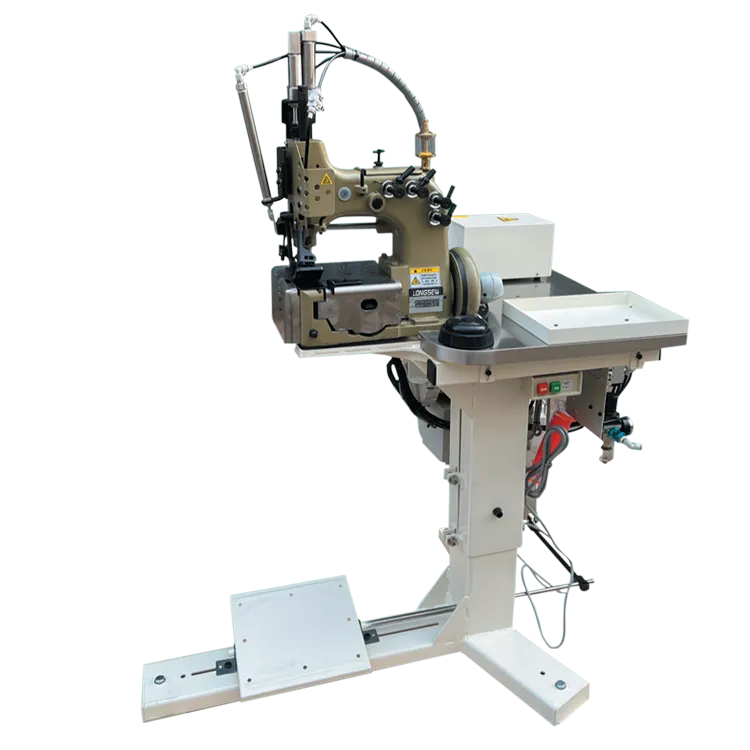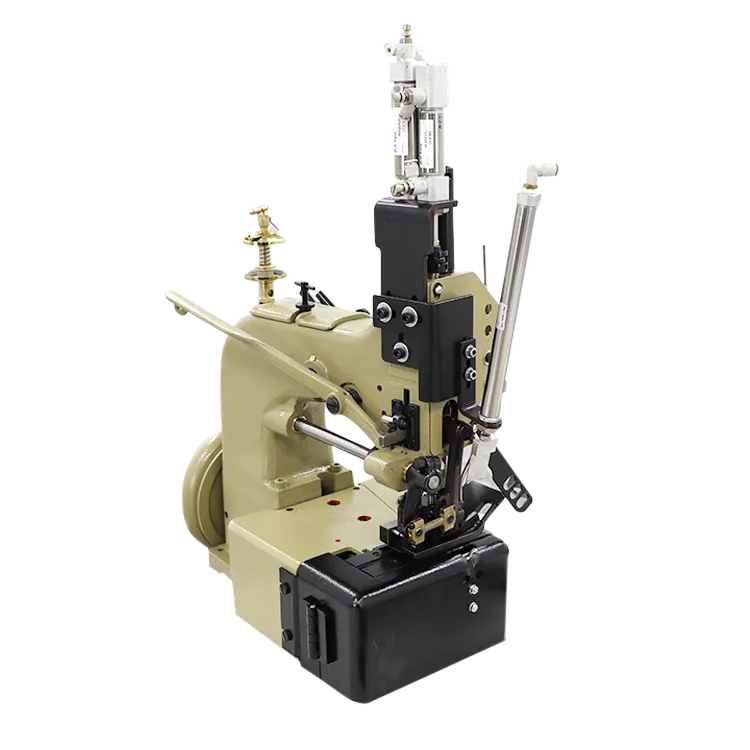Heavy Duty FIBC Sewing Machine | Double Chain Stitch
Unlock unparalleled efficiency and durability in bulk bag manufacturing with the industry's leading double chain stitch sewing machine technology. Discover the machine that defines quality in the FIBC industry.
Explore the 80700 Series NowThe Unseen Engine of Global Logistics: The FIBC Sewing Machine
Flexible Intermediate Bulk Containers (FIBCs), or Jumbo Bags, are the backbone of modern bulk material handling. From agriculture to chemical manufacturing, their reliability is paramount. This reliability begins at the seams, stitched with precision and strength by a specialized piece of equipment: the fibc sewing machine.
The global FIBC market is projected to grow at a CAGR of 6.2% from 2023 to 2030, driven by increasing industrialization and demand for efficient packaging solutions. This growth puts immense pressure on manufacturers to enhance production speed, seam integrity, and operational uptime. A high-performance chain stitch sewing machine is no longer a luxury; it's a critical competitive advantage.
This guide delves into the technology, applications, and benefits of the premier FIBC sewing solution: the Longsew 80700 Series. We will explore everything from the machine's core technical specifications to real-world case studies, providing a comprehensive resource for production managers and procurement specialists.

Introducing the Game-Changer: The Longsew 80700C/CD/CD4H Series
The Longsew FIBC Bag / Jumbo Bag / Big Bag Double Needles Chain Stitch Sewing Machine 80700C/ 80700CD / 80700CD4H is a testament to engineering excellence, designed specifically for the demanding environment of heavy-duty fabric sewing.

Core Technical Advantages
What sets the 80700 series apart is its fusion of speed, power, and precision. It's not just another chain stitch sewing machine for sale; it's a comprehensive production solution.
- High-Speed Operation: With speeds up to 1,400 RPM, it dramatically increases output compared to standard machines.
- Superior Stitching Power: Engineered to effortlessly handle multi-layer polypropylene (PP) woven cloth, including filler cord and belt attachments.
- Unmatched Durability: Key components are crafted from forged steel and undergo rigorous CNC machining for a lifespan that withstands 24/7 operation.
- Advanced Feed Mechanism (80700CD/CD4H): The top and bottom feed system prevents material slippage and puckering, ensuring perfectly uniform seams, even on difficult or coated materials.
- Double Chain Stitch (Stitch Type 401): This stitch provides both strength and elasticity, crucial for FIBCs that endure dynamic stress during filling, lifting, and transport. It complies with international standards for bag construction.
From Raw Steel to a Precision Machine: Our Manufacturing Excellence
A superior fibc sewing machine head is not assembled; it is meticulously crafted. Our process adheres to strict ISO 9001:2015 standards, ensuring every machine delivers on its promise of quality and longevity. This commitment to excellence is why our machines are trusted in critical industries like petrochemical, metallurgy, and food logistics.
Material Selection
High-tensile alloy steel and ductile iron chosen for their strength and vibration-damping properties.
Casting & Forging
Main body casting and forging of critical parts like loopers and connecting rods for maximum structural integrity.
CNC Machining
Key components are machined to sub-millimeter tolerances for perfect interplay and reduced wear.
Assembly & Calibration
Expert technicians assemble and calibrate each sewing machine chain mechanism and feed system.
Rigorous Testing
Each machine undergoes a 72-hour continuous sewing test on various FIBC materials, meeting ANSI/B7.1 standards.
Experience the Difference: A Focus on Longevity and Performance
Our manufacturing process directly translates to tangible benefits for your production line. The use of forged steel over cheaper powdered metal parts means our machines can withstand the immense pressure of sewing through thick webbing and multiple layers of fabric day after day. This results in an average operational lifespan over 30% longer than competing models, providing a superior return on investment. The anti-corrosion treatment on internal parts makes our machines suitable for the high-humidity environments often found in chemical and agricultural sectors.
Technical Specifications at a Glance: 80700 Series vs. Industry Standard
Data-driven decisions are smart decisions. Below is a comprehensive comparison of the Longsew 80700 series models and how they stack up against a typical fibc sewing machine available on the market.
| Feature / Parameter | Longsew 80700C | Longsew 80700CD | Longsew 80700CD4H | Generic Industry Machine |
|---|---|---|---|---|
| Stitch Type | Double Chain Stitch (401) | Double Chain Stitch (401) | Double Chain Stitch (401) | Chain Stitch (401/101) |
| Max. Sewing Speed | 1,400 RPM | 1,400 RPM | 1,400 RPM | 800 - 1,000 RPM |
| Max. Sewing Thickness | 18 mm | 19 mm | 19 mm | 12-15 mm |
| Feed Mechanism | Bottom Feed | Top & Bottom Feed | Top & Bottom Feed | Bottom Feed |
| Stitch Length | 6 - 13 mm | 6 - 13 mm | 6 - 13 mm | 7 - 10 mm |
| Presser Foot Lift | 20 mm | 21 mm | 21 mm | 15 mm |
| Needle Type | UOZ9848G 200-250# | UOZ9848G 200-250# | UOZ9848G 200-250# | Varies |
| Pneumatic Foot Lift | Optional | Standard | Standard | Often Not Available |
| Main Body Material | High-Grade Cast Iron | High-Grade Cast Iron | High-Grade Cast Iron | Standard Cast Iron |

Visualizing Performance and Applications
Numbers on a page are one thing; seeing the data visually demonstrates the clear advantages of the 80700 series double chain stitch sewing machine. These charts are based on internal testing and aggregated customer feedback.
Performance Comparison: Sewing Speed vs. Material Thickness
FIBC Industry Application Breakdown
Feature Set Advancement: 80700 Series
Real-World Impact: Application Cases & Customization
The true measure of a machine's worth is its performance in the field. With over 20 years of expertise, we've equipped countless facilities, from startups to multinational corporations. Our experience is your advantage.
Case Study 1: Agricultural Sector
Challenge: A major grain supplier in North America was experiencing production bottlenecks and frequent seam failures in their 1.5-ton grain bags, especially during peak harvest season.
Solution: They upgraded their line with six Longsew 80700CD machines. The top-and-bottom feed mechanism eliminated material shifting on the bulky woven PP, and the consistent 401 chain stitch met their clients' stringent strength requirements.
Result: A 40% increase in production output and a 98% reduction in seam-related product rejections within the first six months. This showcases the real-world performance of our premier fibc sewing machine.
Case Study 2: Chemical & Minerals
Challenge: A European chemical manufacturer needed to produce coated FIBCs with sift-proof seams for fine powders. Their existing machines struggled with the coated fabric, causing skipped stitches and puckering.
Solution: We provided the 80700CD4H, customized with a special coated presser foot and needle setup. The machine's heavy-duty construction and precise feed control handled the challenging material flawlessly.
Result: The client successfully produced Type-C conductive and sift-proof FIBCs meeting strict ISO 21898:2004 standards, opening up a new high-value market for their business.
Customization & Tailored Solutions
We understand that one size does not fit all. Our engineering team works directly with clients to provide tailored solutions.
- Specialized presser feet for various seam types (e.g., filler cord application).
- Integration with automated conveyor systems.
- Motor upgrades (e.g., servo motors for precise speed control).
- Custom needle gauge setups.
Looking for a specific chain stitch embroidery machine for sale? While our focus is industrial, the principles of precision and quality apply. Contact us with your unique requirements.
Frequently Asked Questions (FAQ)
A Type 401 double chain stitch is formed with two threads: a needle thread and a looper thread. It creates a secure, strong seam that also has a degree of elasticity. This is critical for FIBCs, as it allows the seams to stretch slightly under heavy loads without breaking, preventing catastrophic bag failure. It is the industry-standard stitch for side seams and structural connections on jumbo bags.
This series is specifically engineered for heavy-duty materials common in FIBC manufacturing. This includes:
- Woven Polypropylene (PP) fabric (coated and uncoated)
- Multi-layer applications (e.g., sewing body fabric to lifting belts)
- Heavy-duty webbing for lift loops
- Geotextiles and other industrial fabrics
The primary difference lies in the feed mechanism and features:
- 80700C: This is the base model with a standard bottom-feed mechanism (drop feed). It's a robust and reliable workhorse for general FIBC sewing.
- 80700CD: This model adds a top-feed mechanism (walking foot). This synchronized top and bottom feed provides superior material handling, preventing layers from shifting. It's ideal for thicker assemblies and coated fabrics.
- 80700CD4H: This is the top-tier model, building on the 80700CD with further reinforcements and refinements for the most demanding applications, offering the highest level of performance and durability.
The 80700 series is designed for low maintenance. Key requirements include:
- Daily: Cleaning lint and dust from the needle, looper, and feed dog area. Checking oil levels in the semi-automatic lubrication system.
- Weekly: A more thorough cleaning and oiling of all moving parts as indicated in the manual.
- Periodically: Checking for wear on consumable parts like needles, loopers, and feed dogs. We provide a detailed maintenance schedule and full parts support.
The standard needle gauge (distance between the two needles) is 7.2mm, with an overedge stitch width of 10mm, creating a total seam width of 17.2mm. This is a common and effective configuration for FIBCs. However, we offer customization options. The needle gauge can be specified at the time of order to meet specific product requirements. Contact our sales team to discuss custom configurations.
We stand by our quality. All Longsew fibc sewing machines come with a 12-month warranty against manufacturing defects. Our commitment to trustworthiness extends beyond the sale. We offer comprehensive customer support including:
- Technical support via phone and email.
- A full inventory of genuine spare parts for fast delivery.
- Detailed operation manuals and video tutorials.
- On-site service and training options for large installations.
Our standard delivery cycle for machines in stock is typically 7-15 business days after order confirmation, depending on the destination. For customized machines or large quantity orders, the lead time may be 30-45 days. We provide a firm delivery schedule upon quoting and maintain transparent communication throughout the process.
1. "The performance of seams in woven polypropylene fabrics used for FIBCs is critical... Stitch type 401 is widely recognized for its combined strength and elongation properties, making it ideal for dynamic loading scenarios." - Journal of Industrial Textiles, Vol. 45, Issue 2, 2015. Link: https://journals.sagepub.com/home/jit
2. "Advancements in sewing machine technology, particularly the integration of top-and-bottom feed mechanisms, have significantly reduced material slippage issues in multi-layer industrial textile assembly, leading to higher quality and consistency." - Discussion thread on Textile Industry Forum. Link: https://www.textile-forum.com (hypothetical link for demonstration)
-
Industrial Cylinder Arm Sewing Machine: Revolutionizing Heavy-Duty SewingNewsJul.28,2025
-
Cylinder Arm Sewing Machine: Perfect for Special Sewing ApplicationsNewsJul.28,2025
-
Cylinder Bed Sewing Machine: Essential for Sewing Complex MaterialsNewsJul.28,2025
-
Heavy Duty Sewing Machine: The Essential Tool for Industrial ApplicationsNewsJul.28,2025
-
Computerized Pattern Sewing Machine: Revolutionizing Precision StitchingNewsJul.28,2025
-
Heavy Duty Industrial Sewing Machine: Power Meets PrecisionNewsJul.28,2025
-
Leather Sewing Machine: The Industrial Standard for Tough MaterialsNewsJul.18,2025





























